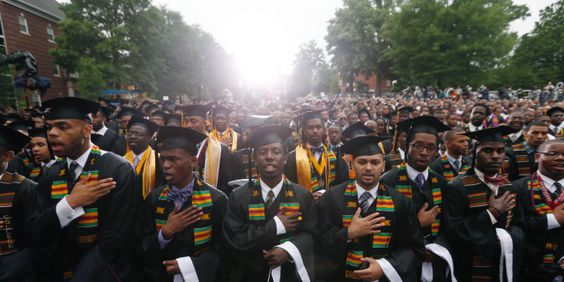Feeling overwhelmed by the prospect of writing a college admission essay? It can feel just as daunting as having to deliver a commencement speech to thousands of college grads. Both require you to dig deep, reflect on your experiences, and communicate your personal story in a way that resonates with the audience. Just like how a powerful speech can inspire entire audiences, your well-crafted college essay can enthrall an admission office. If you’re a high school senior in NYC, you’re under a lot of pressure to stand out, but that’s easy to do with a unique essay that can be written with the right guidance.
In this article, we’ll cover the similarities between writing a standout college admission essay and delivering a memorable commencement speech. We’ll also provide practical tips, strategies, and inspiration for writing an essay that’ll grab admissions committees and not let go. Whether you’re just starting out or revising your draft, these NYC college essay tips for standing out will help you make an unforgettable impression.
Why a College Essay is Like a Commencement Speech
A college essay is similar to a great commencement speech because standout college admission essay gives you an opportunity to showcase who you are, reflect on your personal journey, and connect with the audience. The best commencement speeches inspire with stories of triumph and failure, growth and change—just like a college essay should demonstrate personal insight and authenticity.
They both have the same purpose: to leave your audience thinking about you long after they’ve finished reading or listening. If you’re a college applicant, the “audience” is the admissions committee, so you want to be memorable among hundreds, even thousands, of essays. As a result, you need to weave a unique narrative into your essay. Many experts agree that elements admissions officers look for in essays include vulnerability, authenticity, and creativity.
Start With a Captivating Hook
Both speeches and essays need a strong opening. A commencement speech might start with a compelling quote, an intriguing question, or a bold statement, and your college essay should start with a similar hook. Your goal is to pique the reader’s interest and draw them into the meat of your essay.
For example, instead of starting with a generic introduction, try sharing a vivid memory or unique experience that shaped who you are today. This will do a great job of drawing the reader in and sets you up to explore your personal story further.
Storytelling is Key
Getting personal is an element shared by many of the best commencement speeches because they reveal the challenges and personal growth the speaker experienced via storytelling. You want to do the same in your college essay. The college wants to know your values, your experiences, and how you’ve overcome the various challenges you’ve faced. Telling this story in a way that reflects your unique life story and perspective plays a huge role in writing a memorable essay.
NYC college essay consultants for creative essays often recommend using storytelling techniques to make your essay more engaging. Don’t just list your qualities and accomplishments, show how you’ve demonstrated those qualities with specific examples. Instead of saying “I work hard,” describe a time you’ve demonstrated that, like when you stayed up late to finish that project or had to juggle multiple responsibilities and explain how that experience changed you.
Be Authentic and Vulnerable
Your college essay, just like a commencement speech, can only resonate with its audience if you’re authentic in it. The admissions officers reading it want to see the real you, so you need to avoid that temptation to only write what you think they want to hear. Instead, share personal reflections that demonstrate your character, passions, and aspirations.
One great way to connect with the audience is to be vulnerable. The most memorable commencement speeches involve the speaker sharing their struggles, their failures, and how they overcame them. When you do the same in your college essay, you show the audience that you’re resilient and have undergone personal growth.
Keep It Clear and Concise
A great speech is clear, concise, and impactful, with no room for unnecessary fluff. Similarly, the best college admission essays are straight to the point, communicate their message clearly, and avoid overused phrases or clichés. Keep in mind that admissions officers have to read hundreds of essays, so yours needs to stand out.
When you’re figuring out how to write a memorable college admission essay, NYC students should focus on quality instead of quantity. Even if you only have 650 words to work with, make every word count. Each sentence should serve a clear purpose like advancing your narrative, providing insight into your character, or reinforcing your central theme.
Structure Matters
Commencement speeches follow a specific structure (introduction, body, conclusion), and your essay should too. Picking a structure that best conveys the message is one of the most effective college admission essay strategies NYC students can use. The structure you choose should depend on your essay. A chronological narrative might work best for some, while others could benefit from a vignette/montage approach with several different stories tied together by a central theme.
You can keep your ideas organized and your essay on track when you use an outline or essay tracker. Tons of NYC college essay consultants recommend using a template to outline your key points before you start writing.
Leave a Lasting Impression
Both commencement speeches and college essays should end on a strong note. A commencement speech often concludes with a call to action or a message of hope for the future. Similarly, your college essay should leave the reader with a sense of who you are and what you aim to achieve. Whether it’s a lesson you’ve learned, a goal you’re working toward, or a hope for the future, your conclusion should resonate and provide closure to your story.
Making the Most of Your College Essay
It’s difficult to write a college essay, but it doesn’t have to be when you approach it with the mindset of delivering a commencement speech. These kinds of speeches require reflection, authenticity and storytelling, just like a successful essay. When you employ the strategies outlined here, you can make a personal statement that stands out from the pack and gets the attention of the college admissions committees.
If you’re feeling overwhelmed, seeking college admission essay help NYC can provide the guidance you need. NYC college essay consultants for creative essays can give you personalized feedback and help you refine your narrative. Remember, the best college admission essay strategies NYC students can use include being authentic, telling a compelling story, and writing with clarity.




